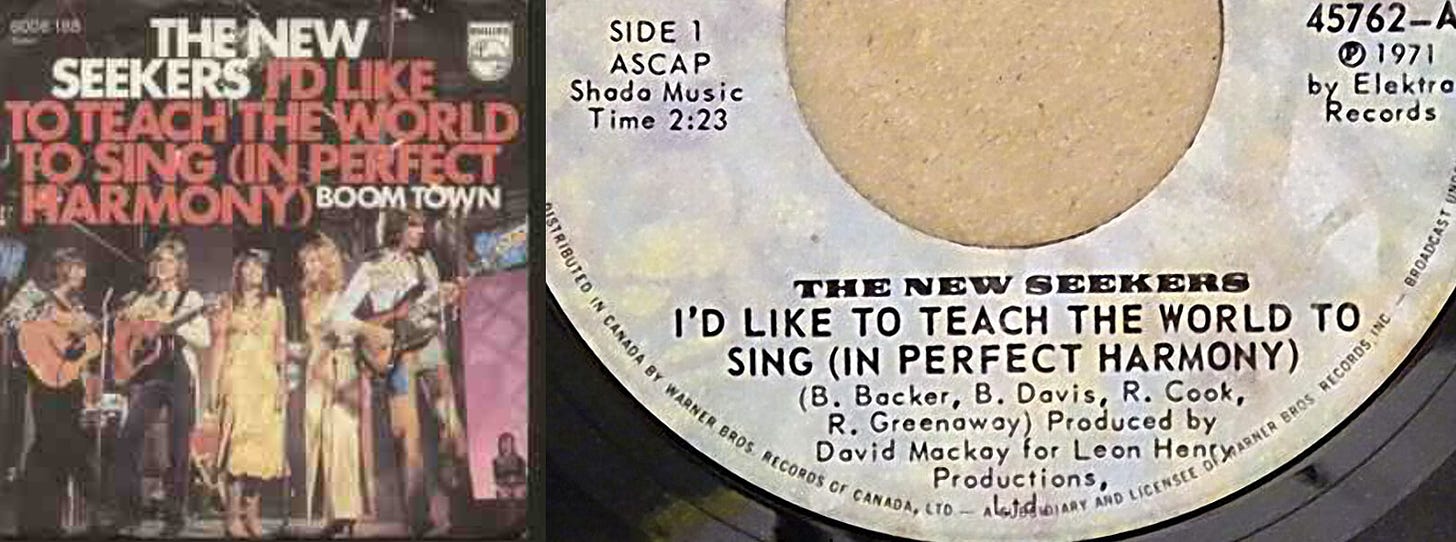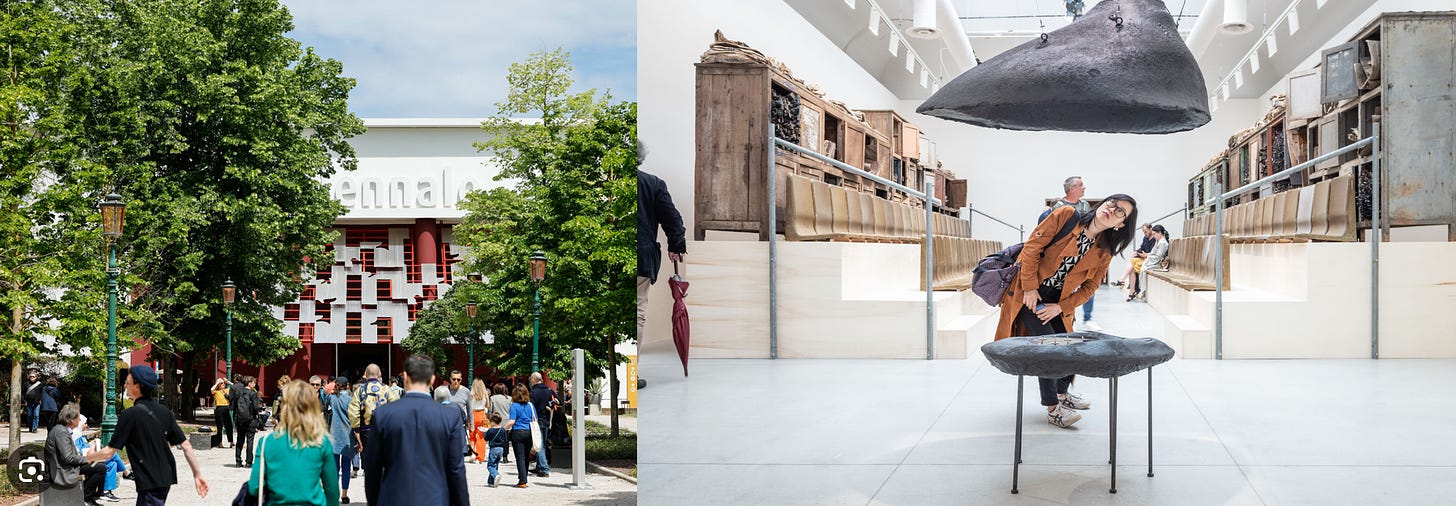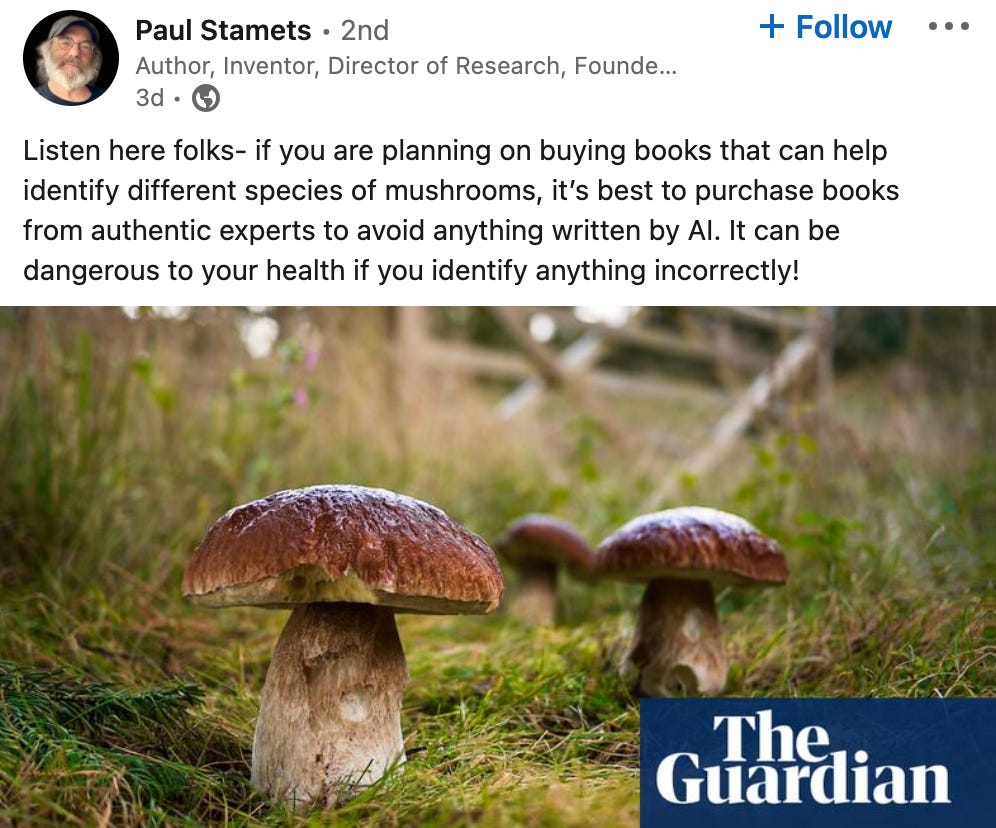From the minds of Sputnik Futures. Exploring every rabbit hole there is. For more wanderings, become an Alice in Futureland subscriber—it's free.
🍄 AudioDose: this is Alice on Sonic Mushrooms: Earthcore Spin
🎧 Alice podcasts
📘 Alice books: Thriving with Microbes: The unseen intelligence within and around us
Hello, we’re Alice and we are always in a state of wander… as it turns out, when you start learning about everything fungi can do, it’s hard not to see them as intelligent, aware beings. Paul Stamets, mycologist and author, states that humans share nearly 50% of their DNA with fungi. As part of the growing revolutionary research about the evolutionary relationships among living things, fungi, like mushrooms, have now been revealed as being closer to animals—like humans, than to plants—like lettuce.
We can see why mushrooms and fungi have come to play a leading role in the social imagination that could greatly benefit humanity.
The universal archetype : Our brain and mycelium
In an article published in Whole Earth Review called Earth's Natural Internet, Paul Stamets, states that the mushroom mycelium is a sentient, neurological landscape. He elaborates that the concept is one that came out of him staring in front of a scanning Electron microscope for ten years. He looked at thousands of specimens and was always amazed when he looked at the architecture of the mushroom mycelium. It was so perfectly designed. He began to realize that the ground is infused with mosaics of mycelial mats which intersperse and overlay one another, and there can be up to two to three hundred species of fungi under one Douglas fir tree and the host defense of the planet is dependent upon these fungal organisms. These giants are what he calls, "neurological landscapes" because they're sentient, they're intelligent. So these fungi are tremendous biological allies for everybody in the ecological community, including ourselves.
Neurological landscapes are sentient, intelligence is a collaborative act.
Could it be this easy? If nature is collaborative and humans are the most evolved species, is it because we have developed, like fungi, the most advanced ways of living, loving and working together? Perhaps the crisis of consciousness we are experiencing today is because we have been going against our collaborative nature. Do we really want to get up every day to compete? Of course not. What if humanity’s obsession with competition is making the human species exhausted, anxious, weaker, fill in the ______? The survival of the fittest mentality has led to a disenfranchised workforce, political unrest, and a disengaged youth culture. So what can we do about this? Perhaps the resurgence of the magical mushroom in pop culture is a part of nature's plan. From a naturalistic, spiritual point of view, could one argue that intelligent mycelial networks are using human brains as kind of a jumping off point in order to reimagine our environment? That may be an extraordinary jump in logic but it has some credibility because insects are being utilized by fungi, plants are being utilized by fungi, we're utilizing fungi, fungi are utilizing us. It's one big complex game that we're a part of. And when we start separating ourselves away from the ecosystem that gave us birth, we're really showing a form of biological myopia. Have we succumbed to super-narrow vision that we're denying the reality of our own existence. Perhaps exploring fungi’s neurological landscapes will lead us to questions such as: What is our role and responsibility? Where are we going? How can we help the planet, how can we support each other? Perhaps the next human resource conference will be curated by Mycologists.
You cannot deny, mushrooms have always played a part of human imagination.
Recent discoveries and novel ideas about fungi are spreading like mycelium. The illuminating Netflix documentary Fantastic Fungi has been seen by millions. The popularity of figures like Paul Stamets and the success of books like Entangled Life by biologist Merlin Sheldrake have spawned a new generation of mycophiles (mushroom lovers).
As culture starts to pay more attention to fungi we can learn how to change the story of life on our planet. After all, mushrooms and fungi influence everything from global climate and vision-quests to food systems and evolutionary biology. In an interview with Atmos magazine, Sheldrake calls them “worldmakers.” As environmental crises have worsened, people have become aware of the many shimmering networks of connection that we’re bound up in,” Sheldrake explains. “Fungi have become ecological poster organisms for this, because they form these persistent physical connections and networks with other organisms.”
What else we are wondering…
🔍 Life lessons from Fungi
Mushies is a company that believes fungi have the potential to help people think better, feel better, and create a better world. It offers 7 Life Lessons From Fungi—from decentralized networks to the necessity of death.
Can we re-teach the world to sing in perfect harmony?
🔍 Paul Stamets gives us a beautiful analogy of how the individual can function as part of a whole. This is particularly useful as we have so few models for true community in our individualist culture. He uses the example of polyphonic singing in terms of describing mycelium, and the way they function. With Polyphonic singing, all voices make up the whole. This differs from singing in harmonies, where someone leads and the others adapt around that voice. In this case, each voice is totally different, singing a unique tune that makes some sense alone, when heard separately. But when they are sung together, you can barely distinguish each separate thread of song, and a new whole is created, which is more than the sum of its parts.
Fungi and art have had a close relationship throughout the history of humanity.
🔍 Fungaltopia
What does a mushroom-based installation at the Venice Biennale tell us about our biological future? Science and art are closely intertwined subjects that have helped each other improve in a mutualistic relationship for numerous centuries.
🔍 Fantastic Fungi: Reimagine Album
As a global society, we are facing challenging environmental, health, and humanitarian issues – the message of the mycelium taps into the heart of these issues – that we are all connected. The album celebrates the integral part music plays in every movement and is curated to foster a commitment to build a more connected and conscious world. We need to open our eyes to nature’s intelligent design and our hearts to nature’s wonders. If we can embrace our fungal partners and ancestors, we can change the fate of our planet from mass extinctions to flourishing environments. We can build communities that celebrate and honor life in its many forms. The double-length album release features original songs, new remixes, and celebrated tracks from some of our favorite artists.
🎧 Listen to Fantastic Fungi: Reimagine Album
👁🗨 Fantastic Fungi – The Magic Beneath Us (Film)
🔍 Crossing nature, technology and society
Cesar & Lois is a collective that probes the evolution of humanity’s relationship to nature by advancing intersections between the parallel networks of technology, biological and societal systems. Led by Brazilian media artist Cesar Baio and California-based media artist Lucy HG Solomon, often in conversation and collaboration with other artists, scientists and researchers.
Some projects include:
Degenerative Cultures consists of a series of “bhiobrid” (bio-digital hybrid) artworks in which living organisms, social networks and Artificial Intelligence work together to corrupt the human impulse to master nature. Replicating the logic of so-called “intelligent” microorganisms, the artists blur the limits between biological and artificial intelligence.
In [ECO]nomic revolution, Cesar & Lois make microbiological mappings across different neighborhoods in order to re-envision the wealth distribution of those neighborhoods.
Audio Meditation: Thinking like a mushroom.
Mycorrhizal Insurrection, a cocoon for a colony of mushrooms becomes a conduit for engaging with mycelial signaling, in a text exchange around climate.
🔍 Fungi to net-zero
Fungi stores a third of carbon from fossil fuel emissions and could be essential to reaching net-zero, new study reveals. Researchers are now calling for fungi to be considered more heavily in conservation and biodiversity policies, and are investigating whether we can increase how much carbon the soil underneath us can hold.
🔍 Follow the magic money
Backed by $17 million of funding, the Johns Hopkins Center for Psychedelic and Consciousness Research is leading the way in exploring innovative treatments using psilocybin, which can penetrate the central nervous system and medical experts are just beginning to understand its effects on the brain and its potential as therapeutics for mental illnesses.
The psychedelic therapeutics market size was valued at 3.94 billion USD in 2022 and is predicted to reach 13.29 billion USD by 2031.
🔍 To assist or not—that is the question
A report in The American Journal of Psychiatry questions if the science and medical community are clear on what they mean by “psychedelic-assisted psychotherapy” or “psychedelic-assisted therapy” when using psychedelics in treating mental health conditions. Researchers claim that the drug as a medication presumably works on the brain (as a “catalyst”), but there is a separate psychotherapy that it facilitates. That psychotherapy is “relationship centered,” which involves counseling. Psychological support provided in recent studies of psilocybin is primarily directed to safety—specifically, the preparation and safeguarding of vulnerable people who are submitting to a potentially disorienting experience. The researchers conclude that “psychedelic-assisted psychotherapy” does not capture the true mechanism of change facilitated by psychedelic experience. The effects observed thus far in the best controlled studies of psychedelic treatment must be attributed to the drug itself and not to psychotherapy.
🔍 Fungi skin reservoir
NIOD Hydration Vaccine (HV) is a "breathing,"adaptive hydration seal for the skin that helps protect against loss of Natural Moisturizing Factors (NMF), utilizing fungi composite organisms, a novel biotechnology-inspired approach to building "water reservoirs.” By rebuilding water density, these organisms are said to help skin look up to 20 years younger.
Craving more?
🎧 Alice in Futureland podcasts
📘 Alice in Futureland books
Thanks for tuning in.
For more wanderings, become an Alice in Futureland subscriber—it's free.
Invite your friends to this mad tea party and let's see how many things we can learn before breakfast.
©2023 Alice in Futureland









